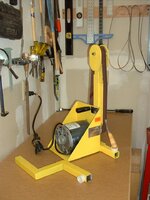I've seen a lot of videos where people consistently use the bottom 2/3rds of the skew (towards the heel of the blade) rather than the tip, for general use spindle turning. For making beads, it's used more like a scraper, and the toe (tip of the tool) sees a lot more action.
I just went through and did some general maintenance on my lathe and lathe tools.
That reminds me, I need to sharpen my thin cutoff tool again...
So, I have a Harbor Freight Tools branded (Central Machinery) 1-inch by 30 inch belt sander combo with a 5-inch disc sander on the side. I modified it by removing the entire disc sander guard assembly and the disc sander itself, installing a pair of 2-inch buffing wheels with washers to keep them on the screw that I'm using as a mandrel (10 - 32 screw, 1 1/4 inches long). This works pretty well as a buffer.
I grind whatever bevel I feel I need, curved or otherwise, dipping the tool every few seconds into a tall container (glass container, used to hold instant tea when I first got it) that I have secured to the workshop table top (it's sitting inside a metal can that is screwed through the bottom into the table top) so that it can't tip over. Glass, because if sparks are flying, it's pretty much immune, and if it were metal, it would leak in no time. The contents? Water, and enough salt that not all of it can dissolve. I keep the lid on it when I'm not using it.
Now, after I'm happy with the sanding (100 grit belt, by the way), I buff the back of the bevel with the cutting edge of the tool turned DOWN so that the edge I just created wont be worn away by the polishing action. This helps ensure that my chisels ride smoothly on the face of my work, and helps raise a micro-burr on the cutting edge for some fine cutting action. Re-buffing as I go keeps the chisel sharper longer without removing much, if any, of the metal.
This method may not work for most, and in fact some of you will likely have pretty big issues with what I do, but it works for me, for now.

